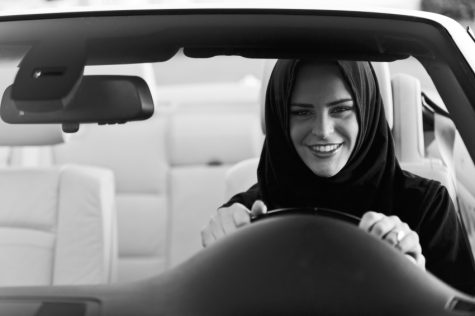Women Driving in Saudi Arabia
Women have finally been granted the right to drive in Saudi Arabia.

On Sept. 26, Saudi Arabia issued a decree that allows women to drive. This comes as a relief to the many women who have protested their rights for years. It seems unimaginable to students at Oakton that there are places in the world that still have so much gender segregation. That women are, in 2017, just now getting the right to drive. Natalie Fitzpatrick, a freshman here at Oakton says, “I think that women should have gotten this right a long time ago. Stereotypically men are more able than women, but it is untrue and it’s upsetting that Saudi Arabia waited until now to realize that.” Although there are still many simple rights women in Saudi Arabia are not allowed, this is one step closer to a less oppressive world.
This ban on women driving has been lifted to allow more women to join the workforce. They had needed a driver to get them to and from work, pushing many women to not have a job to save expenses. With the lift of this ban, more women will be able to do the work they want without waiting for a man to drive them.
In Saudi Arabia, women must be granted permission to get married, have surgery, get divorced, or even to travel. These may seem like things a person should be in control of, women in Saudi Arabia are not given this privilege. For example, a women is not allowed a fair trial in court unless she has four male witnesses, and two other witnesses to testify that these male witnesses are not biased. These only touch on the oppression that women in Saudi ARabia go through every day.
In Saudi Arabia, it is a law that all women must have a “male guardian.” This person must grant them permission to divorce, travel, ect. This is just one example of many of the oppression taking place in Saudi Arabia. But, the women do not seem to mind. In fact, a majority of the women living in Saudi Arabia have stated that they do not support the decision of men and women working, talking, or mixing together. In social events, it is extremely unusual for men and women to socialize. Usually there is a separation between the genders.
Although this is the case for some women, there are still many who are outraged by the oppression. Many protests have been staged, usually including women driving to protest their right. One of the most prominent, however, was Manal al-Sharif in 2011.
Al-Sharif posted a video of herself driving and talking about the ban. She complained that women spend way too much of their money on paying a driver, money they worked hard to get. She explained how it’s humiliating, waiting on the side of the road for a taxi. After this video was posted, Al- Sharif was arrested and held in prison for nine days before a Twitter movement including the hashtag #Women2Drive allowed her to be released. This was not the first time women had stood up against the ban, but it brought awareness to people from other countries about the issue.
With the lift of this ban, Al-Sharif was predictably overjoyed. She posted a picture on her Twitter behind the wheel of a car. She had since moved to Australia, but that did not stop her from showing her delight.
It is true that every women in Saudi Arabia had to have a male guardian to control most of their smallest rights. Male guardians, however, do not have to approve if a women wants to get her driver’s license. When she turns 18, it is her legal right to be allowed to drive. This is a large victory for not only Saudi Arabia, but for women’s rights. Saudi Arabia was the last country to have a ban on women driving, meaning women all around the world now have this right. This will hopefully be the beginning of many positive changes for Saudi Arabian women. 

Hi! My name is Zoe Siamon and I am a junior. This is my third year on the Oakton Outlook staff, and my first year as an editor. I mainly write A&E...









